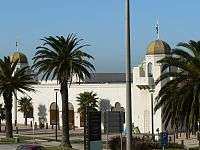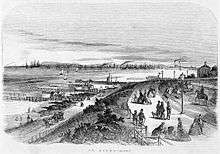St Kilda Sea Baths

The St Kilda Sea Baths are sea baths on St Kilda Beach in St Kilda, Victoria, Australia. The first sea baths were opened in 1860 and rebuilt in 1910 to replace the 1862 "Gymnasium Baths" and have been rebuilt several times since. They closed in 1993,[1] leaving only the front facade.
History


Until the 1850s, sea bathing was not generally considered acceptable. It was permitted within large timber structures as protection from predatory marine life. The St Kilda Sea Baths were opened in 1860, and provided separate sections for men and women. Women were protected from the sight of men bathing because men frequently bathed naked. Sea bathing was popular as it was considered to have health benefits. Throughout the 19th century there were as many as six different sea baths operating along the St Kilda shore.[1]
In 1854, Captain Kenney bought the ship Nancy, which he scuttled south of St Kilda Pier. He ran a line to shore to guide bathers out to the ship. The bathing ship survived until 1912. Kenney also operated ladies’ baths at St Kilda.[1]
An 1856 select committee of the Legislative Council of Victoria recommended the establishment of a Sea Bathing Company at St Kilda of two bathing houses. Construction commenced in 1858 and the baths opened in 1860. They included gymnasium, refreshment rooms, residence, and offices and a 234 x 61 metre swimming enclosure. Bathers formed a club, ‘Companions of the Baths’. Eventually there were at least four separate enclosures. The last, in 1903, was the most exotic with domical clusters overhead and hot sea baths. However, the original baths were destroyed by fire in 1926.[1]
A tramline had been extended to pass St Kilda Beach and the baths in 1925. However, by 1925 bathing in sea baths was becoming less popular, with increasing numbers of people bathing in the open sea. By 1928 men and women were mingling freely in the water and St Kilda Council erected three open-sea changing pavilions along its foreshore: at West St Kilda, on Beaconsfield Parade, at St Kilda Beach (at 40 Jacka Boulevard, which still survives as a restaurant) and at Elwood (Ormond Esplanade, demolished in 1971).[1] The beach pavilions proved more popular than the sea baths.
Replacement baths were built by the Council. It was designed in 1929 by the St Kilda City Engineer’s Department. The City Building Surveyor was Richard Terence who held a certificate in engineering. No architect appears to have been engaged. The new sea baths were no flimsy timber structure, but spacious and solid. The women’s section had Islamic fretwork screens and Moorish domical towers which echo the pairs of domical towers at the Palais, at Luna Park and elsewhere in St Kilda. The men’s section had arcades facing the shore, with wavy Spanish Mission parapets and decoration. Anticipating popularity, 756 lockers were provided for men and 572 for women. The only comparable structures in Victoria are smaller: the Brighton Baths (1936), the Williamstown Pavilion (1936) and the Geelong Eastern Beach Baths (1937).[1]
The Sea Baths opened in 1931. By then, the concept of enclosed sea baths was already outmoded and the baths were never successful as envisaged. The building deteriorated due to lack of maintenance, and by 1950 the wings of the baths which stretched east to sea were considered unsafe and closed.[1] After 1955, under a new operator, the deteriorated men’s baths and the decorative parapets were demolished, and the toilets closed. The women’s section was repaired.
A sequence of night-clubs operated in the structure. In the 1970s one of the most infamous of these clubs was Bojangles. It was notorious for its violence and several deaths. In 1981, the Sea Baths’ concrete wings were demolished. By the mid-1980s, the only operative lease was for the hot Sea Baths which was surrounded by a derelict structure. The night-club had closed and the former café, victim of fires and vandalism.
In 1985, the adjacent St Kilda Pier was rebuilt, but redevelopment of the Sea Baths was not discussed until 1989. In late 1991 the Joan Kirner state government sought redevelopment proposals for the site. In 1993 the Sea Baths closed.
Today the St Kilda Sea Baths contain Australia's only indoor heated sea-water pool, a hydrotherapy spa and a steam room. It also is home to the South Pacific Health Club, and a variety of restaurants and cafes.
Land ownership
The land on which the Sea Baths were built has remained Crown Land, leased by the Council and re-let to an operator, who sub-let various ancillary functions. The 1931 lease expired in 1953. In 1955, the government signed a new lease with South Pacific Holdings.
References
Further reading
- Lynn, Elwyn, Sidney Nolan - Australia. Bay Books. Sydney & London 1979. ISBN 0-85835-382-2. pp46 & 47.
- Emerald Hill Times - The Melbourne Weekly. 16-22 February 2000
- Kelly, Jan. ‘Still not making a splash’. Herald Sun. 15 October 2001. p23.
- Kelly, Jan. ‘Opening sinks delay claims’. Herald Sun. 16 October 2001.
- Kenneth, Joachim. ‘Skinny Dipping in Style’. The Herald. 26 April 1980.
- Kerrick, Jane. Surf still not up at sea baths. Port Philip/ Caulfield Leader. 28 May 2000.
- National Trust of Australia (Victoria). File No 4903.
- Robert Peck von Hartel Trethowan. City of St Kilda Twentieth Century Architectural Study. May 1992. Vol.3.
- Splash. St Kilda Beach and Baths. City of Port Philip, Art and Heritage Unit. St Kilda 2001.
- Szego, Julie. False start: the sea baths saga continues. The Age. 24 July 2001. p5.
- Wells, Lana, Sunny Memories. Australians at the Seaside. Greenhouse Publications. Richmond 1982. ISBN 0-909104-47-6, pp 25, 26, 80, 81, 90 & 93.
External links
Coordinates: 37°51′56″S 144°58′19″E / 37.865421°S 144.971963°E